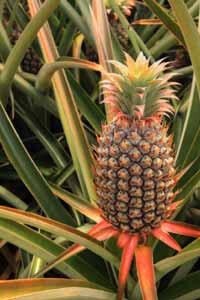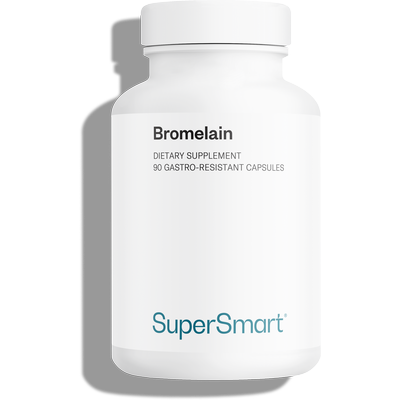12-12-2016
Bromelain, a proteolytic enzyme with multiple properties
 Extracted from pineapple, bromelain is used in Europe to promote recovery following surgery or sporting injuries, as well as to treat sinusitis or phlebitis. Amongst others, it is also used to treat venous disease, bruising, arthritis, rheumatoid arthritis, gout, ulcerative colitis and dysmenorrhea. Bromelain also increases absorption of various medications, in particular antibiotics such as amoxicillin or tetracycline
Extracted from pineapple, bromelain is used in Europe to promote recovery following surgery or sporting injuries, as well as to treat sinusitis or phlebitis. Amongst others, it is also used to treat venous disease, bruising, arthritis, rheumatoid arthritis, gout, ulcerative colitis and dysmenorrhea. Bromelain also increases absorption of various medications, in particular antibiotics such as amoxicillin or tetracycline
The pineapple has a long history of medicinal use among South and Central American populations. Extracts of pineapple pulp and stem were applied to wounds and skin lesions to reduce inflammation. Drinking pineapple juice was known to relieve alcohol-induced stomach ache and indigestion.
Bromelain, the active ingredient in pineapple, was first isolated in 1891 and introduced as a therapeutic supplement in 1957. It is a proteolytic enzyme which is able to digest proteins. It is found in both the stem and juice of the fresh fruit.
Bromelain was first produced in Japan, Hawaii and Taiwan ; the majority of the early research was conducted in the first two of these countries. European scientists subsequently became interested in it and in 1995 bromelain became the 13th best-selling plant-based substance in Germany.
Muscle injuries and surgery
Bromelain is beneficial in the treatment of inflammation and minor tissue injury. An early clinical trial was conducted on 74 boxers with bruising to the face, and haematomas to the eye sockets, lips, ears, chest and arms. Bromelain was administered four times a day for four days or until the bruising had gone. A control group of 72 boxers received a placebo. In 58 of the boxers given bromelain, all signs of bruising had completely disappeared within four days, the remaining 16 requiring 8 to 10 days to be fully healed. In the control group, only 10 subjects had healed in four days, the others taking 7 to 14 days. 1.
In a placebo-controlled, double-blind study involving 160 women who had undergone an episiotomy during labour, those given 40mg of bromelain four times a day for three days after giving birth showed a statistically significant decrease in pain, oedema and inflammation. 90% demonstrated a good or excellent response, compared with 44% in a placebo group2. However, another double-blind study on 158 women who had had an episiotomy found no observable benefit 3.
In a double-blind study, 95 patients being treated for cataract were given 40mg of bromelain or a placebo (alongside their treatment), four times a day for two days before surgery and for five days afterwards. Overall, less inflammation was noted in the bromelain-treated group compared with the placebo group.
Benefits have also been observed in other placebo-controlled, double-blind studies, in dental, nasal and foot surgery. However, a study of 154 subjects who had undergone facial plastic surgery found no such benefit.
Reduces joint pain
Some clinical trials suggest that bromelain may relieve joint pain, a benefit generally attributed to its anti-inflammatory effects though it may also act on physiological pain receptors.
In a clinical study of adult subjects suffering with mild acute knee pain for three months or less, bromelain demonstrated anti-inflammatory and analgesic properties, reducing symptoms of osteoarthritis and rheumatoid arthritis. Subjects were randomly assigned to receive either 200mg or 400mg of bromelain a day. Both groups experienced a significant decrease in pain, but this was more pronounced in the higher dose group. Patients also reported improvement in knee stiffness and physical function. The researchers concluded that “bromelain may be effective in ameliorating physical symptoms and improving general well-being, in a dose-dependent manner, in adults suffering from mild knee pain4».
Anti-coagulant properties
Scientists produced the first conclusive proof that bromelain could prevent platelet aggregation in 1972. Bromelain was administered orally to 20 volunteers with a history of stroke or heart attack, or with high platelet aggregation values. Bromelain reduced platelet aggregation in 17 subjects, normalising them in 8 of the 9 participants with raised platelet aggregation values5.
Benefits for cardiovascular health
Clinical observations have demonstrated that taking 400-1000mg of bromelain a day can reduce the incidence of angina pectoris attacks. After discontinuing treatment, these attacks reappeared. Taking bromelain in combination with potassium and magnesium was also shown to result in a decreased risk of heart attack.
A study of 73 subjects with acute phlebitis showed that treatment with bromelain and analgesics reduced all symptoms of this disease of the venous system.
Mucolytic effect
Bromelain can help with the common cold, asthma or excess mucus production in the respiratory system.
Results of a clinical trial on 124 subjects hospitalised for bronchitis, pneumonia, broncho-pneumonia or other pulmonary disorders showed that taking bromelain reduced mucus viscosity, thus facilitating its elimination from congested airways
Activates the immune response
Doctors in London demonstrated that bromelain, a mixture of cysteine proteases, can stimulate the immune response by inciting production of nitric oxide and TNF-alpha. The researchers concluded that « bromelain may have a role in the activation of inflammatory responses in situations where they may be deficient, such as may occur in immunocompromised individuals6».
Promotes digestion
Bromelain has been successfully used as a digestive enzyme following pancreatectomy in cases of exocrine pancreatic insufficiency and other intestinal disorders. Bromelain, with its wide pH range, exerts its effects in both the stomach and small intestine. Its benefits have also been demonstrated in cases of pepsin or trypsin deficiency.
Experiments on animal models have shown that bromelain heals gastric ulcers. In a large-scale study of its effects on the gastric mucosa, it was found that bromelain increased uptake of radioactive sulphur by half, and that of glucosamine by between 30% and 90%. Increasing uptake of these substances may enable the gastric mucosa to heal more rapidly under the influence of bromelain7.
Boosts antibiotic activity
In many countries, bromelain is used primarily to boost the effect of antibiotics. Bromelain can alter the permeability of certain organs and tissues to different drugs. It prolongs sleeping time in mice given pentobarbital8 and increases penicillin and gentamycin levels in rats.
In humans, it has been shown to increase blood and urine levels of antibiotics and results in higher blood and tissue levels of tetracycline and amoxycillin when they are given alongisde bromelain9.
When 18 women were treated with 80mg of bromelain alongside amoxycillin or tetracycline, increased serum levels and concentrations of both antibiotics were noted in the uterus and ovaries, as compared with controls. This effect was not achieved with indomethacin, an anti-inflammatory drug that acts as a cyclooxygenase inhibitor, suggesting that bromelain has an undetermined activity that enhances absorption and tissue distribution of antibiotics 10.
In a double-blind test, serum tetracycline levels increased three-fold after ingestion of 540mg of bromelain11.
A combined treatment of bromelain and antibiotics was administered to 53 hospitalised patients suffering from either pneumonia, bronchitis, staphylococcus skin infection, thrombophlebitis, cellulitis, pyelonephritis or rectal/peri-rectal abscess. Bromelain was administered four times a day along with antibiotics - either singly or in combination (penicillin, chloramphenicol, erythromycin or novobiacin). A control group of 56 patients was treated with antibiotics alone. Of those patients who showed no improvement from the antibiotic-only treatment, 22 improved following the combined therapy. In each disease, there was a significant reduction in morbidity from the combined bromelain-antibiotic treatment, compared with the antibiotic-only therapy. Another group of 106 patients was treated with bromelain alone, with similar results to those obtained with antibiotic treatment12.
Sinusitis
In a double-blind trial, 48 patients with moderate to severe sinusitis were given bromelain or placebo for 6 days13.
All the patients received a standard treatment of antihistamines, analgesics and antibiotics. 23 of them were also given bromelain four times a day, while the others received a placebo. At the end of the study, nasal inflammation had reduced by 83% in the bromelain group as against 52% in the placebo group. Respiratory difficulties were eased in 78% of the supplemented patients compared with 68% of the placebo group. Overall, good results were observed in 87% of the treated patients, as against 68% of the placebo group. Benefits were also noted in two other studies investigating a total of more than 100 volunteers with sinusitis 14.
Bromelain’s ability to potentiate antibiotics and other drugs may be due to enhanced uptake as well as to increased permeability of the diseased tissue which may boost the antibiotics’ access to the site of the infection. It is also believed that the use of bromelain may provide similar access to specific and non-specific components of the immune system, thus improving the body’s utilisation of its own healing properties.
1- Bronstein J.L., Control off swelling in boxing injuries, Practitioner, 1960; 185: 78.
2- Zatuchi G.I. et al., Bromelains therapy for the prevention of episiotomy paine, Obstet Gynecol. 1967 ; 29: 275-278.
3- Howat R.C. et al., The effect of bromelain therapy on episiotomy wounds - a double-blind controlled clinical trial, J. Obstet. Gynaecol. Br. Commonw., 1972; 79: 951-953.
4- Walker A.F. et al., Bromelain reduces mild acute knee pain and improves well-being in a dose-dependant fashion in an open study of otherwise healthy adults, Phytomedicine, 2002 Dec; 9(8): 681-6. Tilwe G.H. et al., Efficacy and tolerability of oral enzyme therapy as compared to diclofenac in active osteoarthrosis of knee joint: an open randomized controlled clinical trial, J. Assoc. Physicians India, 2001 Jun; 49: 617-21.
5- Heinicke R.M. et al., Effect of bromelain on human platelet aggregation, Experientia, 1972; 28: 844-845.
6- Engwerda C.R. et al., Bromelain activates murine macrophages and natural killer cells in vitro, Cell. Immunol., 2001 May 25; 210(1): 5-10.
7- Felton G. et al., Does kinin release by pineapple stem bromelain stimulate production of prostaglandin E&-like compound, Haw. Med. J., 1976, 2: 39-47.
8- Moss J.N. et al., Bromelains, the pharmacology of th enzymes. Arch. Int. Pharmacodyn., 1963; 145: 168.
9- Tomozzi S. et al., Effect of bromelain on serum and tissue levels of amoxicillin, Drugs Expt. Clin. Res., 1978; 4: 39-44.
10- Luerti M. et al., Influence of bromelain on penetration of antibiotics in uterus, salpinx and ovary. Drugs Expert. Clin. Res., 1978: 4: 45-48.
11- Renzini G. et al., The absorption of tetracycline in combination with bromelain by oral application, Arzneim-Forsch., 1972; 22: 410-412.
12- A plant protease for potentiation of and possible replacement of antibiotics, Exp. Med. Surg., 161; 19: 143-160.
13- Ryan R.E., A double-blind clinical evaluation of bromelains in the treatment of acute sinusitis, Headache, 1967; 7: 13-17.
14- Raub S.J., The use of ananase in sinusitis: a study of 60 patients, Eye Ear Nose Throat. Mon., 1966; 45: 96-98. Seltzer A.P., Adjunctive use of bromelains in sinusitis: a controlled study, Eye Ear Nose Throat. Mon., 1967; 46: 1281-1288
Order the nutrient mentioned in this article

Powerful, multi-benefit proteolytic enzyme. Now in gastro-resistant capsules. New acid-resistant delivery method.
www.supersmart.comFurther reading
28-09-2016
Serrapeptase, or Serratia peptidase, has been used for over 30 years in Europe and Asia to relieve pain, inflammation and excessive mucus production. More than...
Read more22-02-2017
Louis XIV famously suffered from severe constipation and his doctors would regularly ask him: ”Comment allez-vous (How are you)?”, when what they actually meant was:...
Read more20-08-2018
The digestive system is a complex group of organs which continues to reveal new secrets. Research in this area has been growing over the last...
Read more© 1997-2025 Fondation pour le Libre Choix
All rights reserved
All rights reserved
Free
Thank you for visiting our site. Before you go
REGISTER WITHClub SuperSmart
And take advantage
of exclusive benefits:
of exclusive benefits:
- Free: our weekly science-based newsletter "Nutranews"
- Special offers for club members only

















